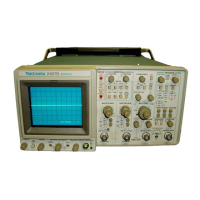Theory of Operation—2465B/2467B Service
ANODE MULTIPLIER. The Anode Multiplier circuit (also
contained in High Voltage Module U4310) uses a 6X
voltage multiplier to produce the +15 kV CRT anode
potential.
It can be thought of as three voltage-doubler
circuits in series.
The first negative half-cycle charges the
0.001
-^.f input
capacitor (connected to pin 8 of the High Voltage Module)
to a value of 2.5 kV through the diode connected to pin
10.
The following positive half cycle adds its voltage to the
voltage stored on the input coupling capacitor via the
second diode, generating +5 kV on the
0.001
-/xi
filter
capacitor connected to pin 10 of U4310. The following
cycles continue to boost up succeeding capacitors to
values 2.5 kV higher than the preceding capacitor until all
six capacitors are fully charged. This places the output of
the last capacitor in the multiplier at +15 kV above
ground potential. Once the multiplier reaches operating
potential,
succeeding cycles replenish current drawn from
the Anode Multiplier by the crt beam. The 1-Mfi resistor in
series with the output to the CRT Anode protects the 6X
multiplier by limiting the anode current to a safe value.
Focus Circuitry
The Focus Circuitry is composed of six control circuits
to drive five CRT Elements. The (1) Dynamic and (2) Static
Focus circuits combine to drive the crt Focusing Electrode
V901 pin 4. The four remaining circuits also affect spot
focusing and they are: (3) PDD Lens and Wall Band Sup-
ply to
J4391.
(4) Rear MCP Supply to TP4302, (5) Astig-
matism to pin 12, and (6) Edge Focus to pin 8.
DYNAMIC FOCUS. The dynamic focus amplifier, in
conjunction with the auto-focus circuitry of Z-Axis hybrid
U950 (diagram 6), provides optimum focus of the crt beam
for all settings of the front-panel INTENSITY control.
The focusing electrode dynamically tracks changes in
the display intensity. The VQ OUT signal, applied to the
crt through the dynamic focus amplifier consisting of
Q4422,
Q4402, Q4403 and associated components is
exponentially related to the VZ OUT (intensity) signal.
To keep the output signal within the dynamic range of
the amplifier, the input is level shifted positive by coupling
capacitor C4412 and clamping diode CR4421 which limits
negative signal peaks to -0.6 volts. Resistor R4414 in
conjunction with feedback resistor R4411 set the inverting
operational amplifier gain to less than one (—.87). Offset
resistor R4415 and feedback resistor R4411 set the DC
output at +60 volts. Emitter follower Q4422 provides
current gain to drive voltage amplifier Q4402 which uses
Q4403 as a constant current
load.
Coupling capacitor
C4411 provides an AC signal to Q4403 to also use it as
an AC voltage amplifier. The output is AC coupled to CRT
pin 4 which is also supplied a high negative DC focus volt-
age from the static focus circuit. Current limiting resistor
R4405 and diodes CR4410 and CR4411 across Q4402
and Q4403 respectively protect the transistors from CRT
voltage transients.
STATIC FOCUS. During calibration, FOCUS
potentiometer R976 is pre-set to mid-range. Focus Range
(R4430) and ASTIG (R977) potentiometers are then set for
optimum focus of the CRT beam at low intensity. After
calibration the Focus Range and ASTIG pots remain as
set, and the FOCUS control is positioned as required
when viewing the displays at various intensity settings.
The static focus amplifier consists of shunt-feedback
inverting operational amplifier Q4432 and associated com-
ponents. The output of the amplifier controls the zero to
-320 volts at
R4431,
the bottom end of the focus range
divider. The negative cathode voltage is connected to
R4434,
the top end of the focus range divider. Static focus
amplifier Q4432 inverts and amplifies the Focus control
voltage, the output sets the voltage at
R4431,
the bottom
end of the focus range divider. The wiper of R4430, the
middle of the focus range divider, supplies the static focus
voltage to the CRT Focusing Electrode, pin 4.
PDD LENS AND WALL BAND SUPPLY (-1 kV). The
Wall Band Supply consists of high voltage transistor
Q4440,
four 200 V Zener diodes, and associated circuitry.
Voltage divider resistors R4441 and R4442 provide -1 kV
to the base of Q4440, an emitter follower pass transistor.
Q4440 provides current gain and —1 kV for the PDD Lens
and Wall Band CRT elements through current limiting
resistor R4472. Q4440 also provides current and voltage
to set the MCP Rear Supply.
MCP REAR SUPPLY (-1.1 kV). The MCP Rear Supply
consists of 100-V Zener diode VR4450 which is connected
to Q4440 in the Wall Band Supply, and R4440, which is
connected to the -2 kV Cathode supply. It supplies
—1.1-kV to the rear of the MCP through current limiting
resistor
R4471.
Diode CR4440 protects the base of Q4440
against reverse bias conditions.
ASTIGMATISM. Initially, at the time of adjustment, the
FOCUS and ASTIGmatism potentiometers are set for
optimum focus of the crt beam at low intensity. After that
initial adjustment, the ASTIG pot normally remains as set,
and the FOCUS control is positioned as required while
viewing the display.
The ASTIGmatism amplifier is composed of U4332B
(operational amplifier integrator), Q4454, and associated
components. The small input control voltage of zero to +5
volts DC is inverted by U4332 and the output voltage is
3a-45

